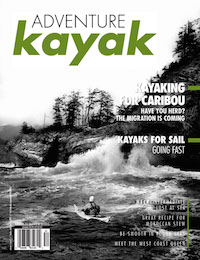Rough conditions call for advanced sea kayaking paddling techniques such as bracing, surfing and rolling, right? Not so fast. Long before those skills are needed, you need to concentrate on flexing from the waist.
When paddling over an oncoming wave, the bow climbs the wave face, crests it and continues down the far side. Adjusting to the change in your boat’s angle as the bow tilts upward and then downward is very natural. You simply lean forward and backward from the waist, keeping the upper body in a neutral position while the kayak rides over the wave. Your head stays over the centreline of the kayak and stability is maintained.
Leaning forward or backward in a kayak this way comes naturally, but flexing edge to edge is far more counterintuitive—and important. If you stay rigid at the waist when waves hit broadside and the boat tilts on edge, your upper body and head will lean over the centreline, throwing you off balance.
To keep the boat stable, your waist needs to stay supple and operate like a universal joint, allowing the kayak to tilt freely in all directions, keeping the upper body and head centred over the boat. By flexing at the waist, you let the kayak and lower body move as one unit, independent from the upper body. The ability to maintain this co-operative division between upper and lower body is what separates upright paddlers from those with well-practiced self-rescue techniques.
Remaining relaxed in choppy conditions is the key to staying flexible and supple. Breathe deeply and drop those shoul- ders, relieving any built up tension. Focus on a nice comfort- able breathing rhythm and match it to the pace of your strokes.
Paddling in calm water while rolling your hips (and the kayak) from side to side is a good way to warm up and be sure you’ll remember your waist’s full range of motion when you need to call on it for stability.
Think of relaxing your hips and waist as a skill in the same category as bracing, surfing and rolling; they all take time to develop. Whether it takes buying a hula-hoop, taking up belly dancing or simply stretching more often, get those hips loosened up, and remember to use them.
Alex Matthews keeps his hips doing their thing while guiding kayaking trips in B.C. and Baja.




